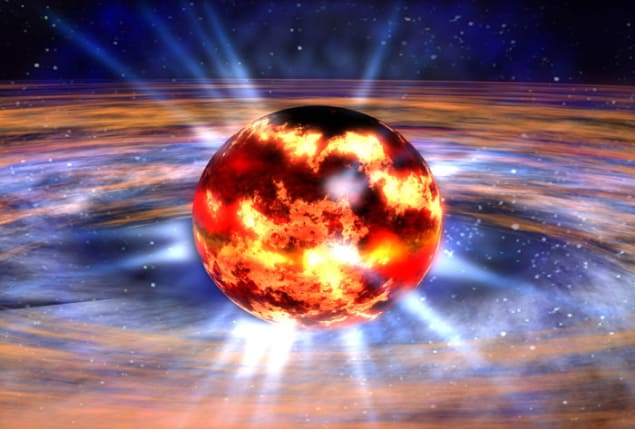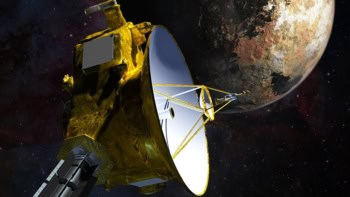
Precious elements may come from spinning neutron stars that have swallowed a tiny black hole and imploded. If true, this dramatically changes our understanding not only of how rare elements like gold are made, but also the nature of some dark matter.
The elements in question include all atoms heavier than bismuth, as well as some neutron-rich isotopes heavier than iron. They are forged in what is called the r-process (meaning ‘rapid’), which requires copious numbers of neutrons as well as densities ten billion times greater than those found in the Sun’s core to enable the rapid capture of those neutrons by atomic nuclei. Therefore, the r‑process can only take place in the most extreme environments.
In 1957, Burbidge–Burbidge–Fowler–Hoyle (known as B2FH) proposed that core-collapse supernovae were the origin of the r‑process elements, but in recent years this has fallen into doubt. Binary neutron star mergers have emerged as a frontrunner, but there’s a problem: with an estimated merger rate of one per 100 000 years, computer simulations struggle to recreate enough r-process elements.
If George Fuller of the University of California, San Diego and his colleagues Alex Kusenko and Volodymyr Takhistov of the University of California, Los Angeles are right, then it’s time for a new explanation. They propose that tiny primordial black holes could become lodged inside a neutron star’s core, where the black hole begins to consume matter and grow. As the neutron star’s interior swirls around the black hole that is eating it, the neutron star begins spinning rapidly and ejects up to a tenth of a solar mass of neutron-rich material into space. This dense material decompresses, allowing beta decay to transform some of the neutrons into protons, which is followed by the rapid formation of massive atomic nuclei.
Hypothetical black holes
The hypothesis, presented in Physical Review Letters, hinges on the requirement that “a few per cent or more of the dark matter is comprised of black holes,” Fuller says. Conceived by Stephen Hawking and theorized to have formed in the immediate moments after the Big Bang, researchers are yet to discover a primordial black hole, which would have a mass similar to that of an asteroid. If they do exist, they would follow the distribution of dark matter, with many of them in the galactic centre. Much like dark matter, they would barely interact with ordinary stars and planets. It’s only neutron stars that would be dense enough to capture them.
Nor should we worry about one hitting Earth. “In the entire history of our planet there is a chance of between 1 in 10 000 and 1 in 100 000 that one of these primordial black holes would pass through Earth,” explains Fuller. “It would just go right through and certainly wouldn’t be stopped by the Earth.”
Things now hinge on observations. Merging neutron stars produce gravitational waves as they spiral into a collision. The Advanced LIGO gravitational wave detector should be able to detect these final stages of a merger at a rate of at least 40 per year, out to a distance of 650 million light years.
“That’s the supreme court in my view,” says Fuller. “If we see binary neutron star mergers with LIGO, then we’ll get a thumbs-up or a thumbs-down on whether the merger rate is high enough.”
Smoking gun
Meanwhile, we may already have found evidence for neutron star–primordial black hole interactions without realizing it. Mysterious fast radio bursts (FRBs) could originate from the neutron star implosions. The destruction of neutron stars could also explain why there are fewer pulsars found in the galactic centre than expected, while beta decay during the r-process could provide the anomalous positron signal at 511 keV that comes from the centre of the Milky Way.
More direct evidence for neutron star implosions could come in the form of kilonovae – bursts of light with a tenth to a hundredth of the brightness of a normal supernova and which are currently thought to be the “smoking gun for a binary neutron star merger and r-process production”, says Fuller. However, if we detect a kilonova within 650 million light years without any accompanying gravitational waves, “that would be suspicious and would look a little bit like the destruction of a neutron star, either by our black hole scenario or by eating some other kind of dark matter and being destabilized”.
There could still be a bump in the road. Earlier this year, Tim Linden of Ohio State University and Joseph Bramante of the Perimeter Institute published a pre-print on arXiv suggesting that low-mass dark matter particles could also accumulate within neutron stars, causing them to implode.
Linden says that he and Bramante calculated the interaction rate between neutron stars and primordial black holes as being “significantly smaller” than that calculated by Fuller’s team. “This is primarily due to different assumptions for the velocity dispersion of neutron stars and primordial black holes very near the galactic centre,” Linden explains. The two groups plan to sit down in the coming months and address these differences.



